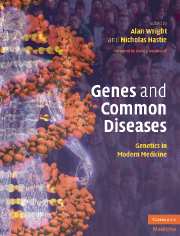Book contents
- Frontmatter
- Contents
- List of Contributors
- Foreword
- Section 1 Introductory Principles
- Section 2 Common Medical Disorders
- 13 Developmental disorders
- 14 Genes, environment and cancer
- 15 The polygenic basis of breast cancer
- 16 TP53: A master gene in normal and tumor suppression
- 17 Genetics of colorectal cancer
- 18 Genetics of autoimmune disease
- 19 Susceptibility to infectious diseases
- 20 Inflammatory bowel diseases
- 21 Genetic anemias
- 22 Genetics of chronic disease: obesity
- 23 Type 2 diabetes mellitus
- 24 Genetics of coronary heart disease
- 25 Genetics of hypertension
- 26 Obstructive pulmonary disease
- 27 Skeletal disorders
- 28 The genetics of common skin diseases
- 29 Molecular genetics of Alzheimer's disease and other adult-onset dementias
- 30 Major psychiatric disorders in adult life
- 31 Speech and language disorders
- 32 Common forms of visual handicap
- 33 Genetic and environmental influences on hearing impairment
- 34 Pharmacogenomics: clinical applications
- Index
- References
33 - Genetic and environmental influences on hearing impairment
Published online by Cambridge University Press: 17 August 2009
- Frontmatter
- Contents
- List of Contributors
- Foreword
- Section 1 Introductory Principles
- Section 2 Common Medical Disorders
- 13 Developmental disorders
- 14 Genes, environment and cancer
- 15 The polygenic basis of breast cancer
- 16 TP53: A master gene in normal and tumor suppression
- 17 Genetics of colorectal cancer
- 18 Genetics of autoimmune disease
- 19 Susceptibility to infectious diseases
- 20 Inflammatory bowel diseases
- 21 Genetic anemias
- 22 Genetics of chronic disease: obesity
- 23 Type 2 diabetes mellitus
- 24 Genetics of coronary heart disease
- 25 Genetics of hypertension
- 26 Obstructive pulmonary disease
- 27 Skeletal disorders
- 28 The genetics of common skin diseases
- 29 Molecular genetics of Alzheimer's disease and other adult-onset dementias
- 30 Major psychiatric disorders in adult life
- 31 Speech and language disorders
- 32 Common forms of visual handicap
- 33 Genetic and environmental influences on hearing impairment
- 34 Pharmacogenomics: clinical applications
- Index
- References
Summary
Prevalence of hearing impairment
Hearing impairment is undoubtedly a common disease. Around 1.06 per 1000 children are born with a significant, permanent hearing impairment (40 dB or greater increase in threshold in their better hearing ear), and by the age of nine years, this number has risen to around 1.65 per 1000 (Fortnum et al., 2001). The prevalence of hearing impairment continues to increase with each decade of life, until 40% of the 71–80 years age group and 80% of the 80+ age group have a hearing loss of 35 dB or more (Davis, 1989; Davis and Moorjani, 2002). In total, approximately 20% of all adults over 18 in the UK suffer some form of hearing impairment (25 dB or greater hearing loss in at least one ear), and the proportions for other countries are very similar (Davis and Moorjani, 2002). The increase at various impairment levels is illustrated in Figure 33.1. However, thresholds are a crude reflection of the impairment, because it is not just the amplitude but the clarity of hearing that is affected. Our ability to distinguish speech sounds, to focus on specific sound sources such as one speaker in a noisy room, and to localize sounds in the environment all require accurate frequency and temporal discrimination, features that are disproportionately affected by hearing impairment. Much hearing loss with age affects sensitivity to high frequencies first, although some types of hearing loss have a more even effect across the frequency spectrum.
- Type
- Chapter
- Information
- Genes and Common DiseasesGenetics in Modern Medicine, pp. 505 - 515Publisher: Cambridge University PressPrint publication year: 2007
References
- 2
- Cited by



